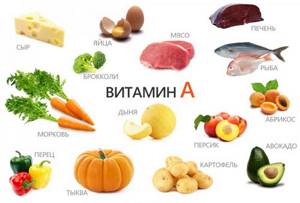In order to be healthy, every person needs a daily dose of vitamins. The vitamin set is contained in many products that are available in any quantity, every day.
Vitamins will help make your daily diet as healthy as possible: A, B, C, D, E. This vitamin composition will enrich the diet and contribute to the quality functioning of all organs.
We will consider below which foods contain the largest amount of vitamin reserves.
Why do we need vitamin A?
Vitamin A has two forms. Retinol is a ready-made vitamin A found in foods of animal origin. And the carotenoid is provitamin A (first derived from carrots). When ingested, it is converted into vitamin A. Carotenoids enter the body with vegetables, seasonings and fruits.
Retinol is involved in the redox processes of the human body. Helps heal inflammation and wounds on the skin - for example, psoriasis or eczema. Develops local immunity through the mucous membranes of the mouth and nose. Participates in the formation of sex hormones, and during pregnancy is responsible for ensuring that the embryo receives nutrition.
Doctors recommend vitamin A for the treatment of many diseases: bronchitis, dysentery, psoriasis, diseases of the eyeball, rickets, mastopathy, liver cirrhosis, leukemia and many others.
Vitamin A for face, hair and nails
Vitamin A is not afraid of exposure to high temperatures, but is extremely sensitive to ultraviolet radiation. Therefore, products and products containing it should be protected from exposure to sunlight.
For facial skin
Vitamin A is a basic substance responsible for skin health and guarantees its firmness and elasticity. If its content is normal, the likelihood of age spots, acne, blackheads, dryness and dullness of the skin is minimized.
Vitamin A is sold in pharmacies. It can be purchased in capsules, as an oil solution or ampoules. You should not thoughtlessly use it for skin care, as the substance has high biological activity. It is recommended for use by people over 35 years of age.
Masks are made with vitamin A. To enhance the effect, various auxiliary components are added to them, for example, full-fat sour cream, burdock or olive oil, aloe juice, oatmeal, honey.
To get rid of small facial wrinkles and bruises under the eyes, apply the drug Aevit or a mixture of vitamin A and oil to the skin.
A mask based on vitamin A, ground lentils and zinc ointment helps get rid of acne. This composition needs to be applied once every 2 weeks. Contraindications to its use are open wounds on the skin, or an allergy to any component included in the composition.
For nails
To care for nail plates, vitamin A is used in conjunction with various components. In addition to retinol, to prepare the mask you will need:
- Vitamin B and D.
- Oily hand cream.
- Coconut oil.
- Lemon juice.
- 1-2 drops of iodine.
All components are mixed and applied to the nails and skin of the hands, rubbing in with light massaging movements. This composition helps to significantly improve the condition of the skin of the hands and nails.
For hair
Vitamin A is added to shampoo before each hair wash. You should not immediately pour it into the shampoo bottle, as it will oxidize. To give hair shine, strength and softness, vitamin A is added to ready-made masks.
You can enhance the effectiveness of the product with the help of auxiliary components: vitamin E, oils, decoctions of horsetail or chamomile, starch. Pepper and mustard accelerate hair growth.
People allergic to vitamin A should use such masks with caution. It is not recommended to use them if the sebaceous glands are overactive.
[Video] A practicing cosmetologist explains how to properly use retinol in cosmetology:
Daily value of vitamin A
The dosage of retinol depends on the age and gender of the person. So, adult men need 650-950 mcg of vitamin A. Women need a little less - 600-800 mcg. For pregnant women, the daily requirement increases by 100 mcg, and for nursing mothers - by 410 mcg of this vitamin.
The children's norm varies between 400-1000 mcg. If there is a shortage, the dosage is increased to 3000 mcg.
Vitamin A is best absorbed with fatty foods. Remember: when cooking, foods fortified with vitamin A lose up to 40% of retinol.
Instructions for use of vitamin A
Indications for use of vitamin A:
- Treatment and prevention of hypovitaminosis. The basis for prescribing retinol may be characteristic symptoms: weight loss, frequent infectious diseases, headaches, ulcerative defects on the mucous membranes of the oral cavity. Vitamin A deficiency can be detected through laboratory tests.
- Treatment of infectious diseases. In this case, vitamin A is prescribed together with vitamin C.
- Rickets. Retinol is used in combination with vitamin D.
- Nyctalopia (night blindness). Vitamin A is used in combination with nicotinic acid.
- Dermatological diseases, such as pustular dermatitis or psoriasis.
Vitamin A preparations are suitable for oral administration in the form of capsules, powders, dragees, solutions, tablets. Its intramuscular and intravenous administration is also acceptable. They make lotions, applications, dressings, etc. with it.
Injection of vitamin A is permissible only in a hospital, with severe retinol deficiency, or in the treatment of severe diseases of the digestive, respiratory and genitourinary systems.
The substance is applied locally in the form of an oil solution for ulcerative defects, wounds, eczema, burns, frostbite.
Oral administration is practiced in the treatment of mild hypovitaminosis. Daily dose of the drug: 3-5 tablets, after meals. The oil solution is applied to a piece of black bread in the amount of 10-20 drops 3 times a day.
The course can last from 14 days to 4 months. The exact timing depends on the specific clinical case.
Taking the vitamin for 30 days is indicated for the following conditions:
- Hypovitaminosis.
- Night blindness.
- Inflammation of the dermis and mucous membranes.
- Strengthening the immune system.
This should be followed by a break of 2-3 months, after which the course is repeated.
The injection dose for adult patients is 10,000 - 100,000 IU, and for children 5,000 - 10,000 IU. The total number of injections can be from 20 to 30.
For oral administration and intramuscular administration, the maximum single dose is 50,000 IU (15,000 mcg or 15 mg). The maximum daily dose is 5,000-10,000 IU per day.
Vitamin A deficiency
The main symptom of vitamin A deficiency is the appearance of “night blindness”. When the eyes take a long time to adjust when the lighting changes. It's time to sound the alarm if, when moving from a brightly lit room to a dark one, your eyes take more than 30 seconds to adapt.
A lack of vitamin A is indicated by tearing and burning of the eyes in the winter sun or in bright light. And also dry “goose bumps” on the elbows and thighs. It is also worth taking a course of vitamin A if you have dry mouth, nose, or throat.
Contraindications and precautions
Consuming excess amounts of vitamin A can be dangerous to your health. With a balanced diet, the daily dose can be easily obtained without the use of specific additives, from ordinary products. For adults, the upper daily limit is 3,000 mcg (10,000 IU). Very high doses can cause severe poisoning and even death.
Overdose symptoms:
- Deterioration of visual function.
- Joint pain, bone pain.
- Lack of desire to eat.
- Nausea and vomiting.
- Photosensitivity.
- Baldness.
- Headache.
- Dry skin.
- Liver damage.
- Yellowing of the skin.
- Stunted growth.
- Dizziness.
- Skin itching.
Excessive amounts of vitamin A are dangerous during pregnancy. Overdose carries a risk to the health of the mother and fetus. There is evidence that hypervitaminosis of vitamin A increases the risk of developing lung cancer in smokers. Therefore, you need to take retinol supplements carefully and strictly follow the dosage.
Signs of severe vitamin A deficiency
Vitamin A deficiency develops if a person consumes few foods containing this substance. Alcoholism and malabsorption aggravate the situation. You can understand that the body is experiencing a lack of vitamin A by the following signs:
- Night blindness. This is the first signal of existing hypovitaminosis.
- Corneal ulcers. With severe vitamin A deficiency, vision can be lost completely.
- Immunodeficiency.
- Frequent respiratory infections. Among children with vitamin deficiency, there is a higher mortality rate from measles.
- Diarrhea.
- Impaired growth and bone formation.
- COPD, pulmonary emphysema. Obstruction most often develops in smokers.
Signs of excess vitamin A
Symptoms of acute vitamin A hypervitaminosis:
- Nausea.
- Headache.
- Decreased performance.
- Loss of appetite.
- Dizziness.
- Dry skin.
- Brain swelling.
Chronic hypervitaminosis of vitamin A can cause the development of osteoporosis, as well as birth defects in the fetus. In this regard, retinol derivatives are especially dangerous, so it is better for pregnant women to be prescribed beta-carotene.
People with an increased risk of lung cancer, smokers, and people whose bodies are exposed to asbestos should not take vitamin A supplements for a long time.
Excess vitamin A
With long-term use, the vitamin accumulates in the liver. Then it becomes toxic to the body. Vomiting, dizziness, diarrhea, and yellow discoloration of the skin may occur.
Pregnant women should especially carefully monitor the dosage of retinol. If it is in excess, fetal development is disrupted. And the baby may be born with a congenital defect of the skull or bones.
What the doctor said
– Vitamin A is responsible for the growth of the body, for its development. That's why it's so useful for children. It also affects the normal condition of the skin and mucous membranes. With a lack of vitamin A, all kinds of viruses cling faster - the same flu, ARVI. Therefore, any bacteria first gets on the mucous membrane, and if it is not properly protected, then the virus enters further into the body.
This vitamin also regulates twilight and color vision. It is also called the “vitamin of beauty and youth” because it is responsible for skin renewal.
It is better to get vitamin A through its natural sources - plant and animal foods, because in artificial form it does not work well. And even when at one time it was a very popular opinion that beta-carotene prevents lung cancer, it turned out that in smokers, on the contrary, it can cause lung cancer. Also, pregnant women should not consume a lot of vitamin A. In case of an overdose (when using synthetic drugs), there is a risk of fetal deformation, said nutritionist Elena Solomatina, Candidate of Medical Sciences .
Functions and biological role of vitamin A in the human body
The importance of vitamin A for the human body:
- Regulation of the synthesis of steroid hormones and proteins.
- Activation of spermatogenesis.
- Antitumor activity.
- Normalization of metabolism.
- Formation of lipids and bone tissue.
- Improving skin condition, accelerating cell regeneration.
- Improving the quality of nails and hair. Vitamin A makes them stronger and enhances their ability to withstand destructive factors.
- Neutralization of free radicals.
- Strengthening the immune system.
- Helping the body fight infectious diseases.
- Promotes proper growth and development of the embryo.
- Improving the function of twilight vision by stimulating the formation of rhodopsin.
- Prevention of inflammatory diseases of the cornea.
[Video] Briefly about the main functions of vitamin A and its role in the human body:
Vitamin E in milk products
Dairy products contain vitamin e in small quantities and are essential. This is due to the fact that babies need tocopherol for proper functioning. Thus, 100 g of product contains:
- Whole milk is a source of 0.093 mg of tocopherol.
- The cream contains approximately 0.2 mg.
- Sour cream contains 0.12 mg tocopherol.
This same group of products includes fermented milk products and cheeses. But it is important to note that during long-term storage the vitamin is stored in very small quantities, almost imperceptible to the body.
Vitamin A (Retinol)
General characteristics of vitamin A (Retinol)
Vitamin A (Retinol) was discovered in 1920 by a group of scientists, it is the first vitamin discovered.
Scientists, after much research, came to the conclusion that butter and the yolk of a chicken egg contain a substance associated with lipoids necessary for the growth of animals; they also showed that butter contains an active principle that is not destroyed by the action of alkalis and remains outside during saponification saponified fraction. This substance was designated "fat soluble factor A" and was later renamed vitamin A.
Other names for vitamin A are Anti-infective vitamin, anti-xerophthalmic vitamin, retinol, dehydroretinol.
There are two forms of this vitamin: ready-made vitamin A (retinol) and provitamin A (carotene), which is converted into vitamin A in the human body, so it can be considered a plant form of vitamin A.
It has a pale yellow color that is formed from the red plant pigment beta-carotene. During heat treatment, it almost does not lose its properties (only 15-30%), but in combination with air during long-term storage it is destroyed.
Physicochemical properties of vitamin A
The vitamin A group includes the following compounds: Retinol, Retinal, Retinoic acid, Retinol palmitate, Retinol acetate.
Vitamin A is a cyclic unsaturated alcohol, which, when oxidized in the body, forms vitamin A-aldehyde and retinoic acid.
Food Sources of Vitamin A
Foods rich in vitamin A - carrots, pumpkin, bell peppers, spinach, broccoli, green onions, parsley, peaches, apricots, apples, grapes, watermelon, melon - are plant sources (carotenoids); Animal sources include fish oil and liver (especially beef), followed by butter, egg yolks, cream and whole milk.
Cereal products and skim milk, even with vitamin supplements, are unsatisfactory sources, as is beef, which contains negligible amounts of vitamin A.

Daily requirement for vitamin A
The recommended daily dose of vitamin A is:
- Infants: 0-6 months. – 400 mcg; 7-12 months – 500 mcg
- Children: 1-3 years – 300 mcg; 4-8 years – 400 mcg
- Men: 9-13 years old – 600 mcg; 900 mcg (3000 IU) for 14-70 years
- Women: 9-13 years – 600 mcg; 700 mcg (2300 IU) for 14-70 years
- Pregnant women: under 19 years old – 750 mcg; 19-50 years old – 770 mcg
- Women breastfeeding: under 19 years old – 1200 mcg; 19-50 years old – 1300 mcg
For diseases associated with retinol deficiency, the dosage can be increased to 10,000 IU per day (calorizer). (The above dosages apply exclusively to the retinoid form of vitamin A. The carotenoid form is not as toxic).
Retinol can be obtained from pharmaceutical supplements (which is 1/3 of the daily requirement), and 2/3 of this vitamin can be obtained from natural foods that contain carotene, such as sweet peppers or carrots.
Beneficial properties of vitamin A
Vitamin A (retinol) is a fat-soluble vitamin, an antioxidant, essential for vision and bones, as well as healthy skin, hair and immune system function. Retinol is involved in redox processes, regulation of protein synthesis, promotes normal metabolism, the function of cellular and subcellular membranes, plays an important role in the formation of bones and teeth, as well as fat deposits; necessary for the growth of new cells, slows down the aging process.
Vitamin A fights viruses and bacteria well, helps strengthen nails and speed up wound healing.
It has a good effect on the reproductive system of men and women, increases the activity of the production of sex hormones.

Harmful properties of vitamin A
Vitamin A can be harmful if overdosed. When there is an excess of it, the body is poisoned and manifests itself in the following symptoms: loss of appetite, nausea, headache, inflammation of the cornea, enlarged liver (calorizator).
Pregnant women should use this vitamin with caution, because An excess of Retinol can lead to developmental disorders of the fetus and the appearance of various congenital pathologies in the child.
Vitamin A absorption
Vitamin A is fat-soluble, so it requires fats as well as minerals to be absorbed by the digestive tract.
Its reserves remain in the body long enough that it does not need to be replenished every day.
Vitamin A deficiency in the body
With a deficiency of vitamin A, night blindness develops, a skin rash appears, the skin peels off, premature aging begins, increased susceptibility to various diseases, visual acuity decreases, dry eyes occur, conjunctivitis develops, dandruff and hair loss appear, and appetite decreases.
Excess vitamin A in the body
With an excess of vitamin A, the following symptoms appear: nausea, vomiting, drowsiness, headache, lethargy, redness of the face, pain in the bones of the lower extremities, menstrual irregularities.
Participation in the vision process of vitamin A
Carotenoids (ie, plant sources of vitamin A) are the main sources of protection for our eyes, they help prevent cataracts, and also reduce the risk of macular degeneration, which is the main cause of blindness.
Participation in the body's antioxidant defense of vitamin A
Vitamin A is an essential component of the body's antioxidant defenses, especially carotenoids. It promotes its interaction with free radicals, including oxygen free radicals - this is the most important feature of the vitamin, which allows it to be considered an effective antioxidant.
The antioxidant effect of vitamin A plays an important role in the prevention of heart and artery diseases, also has a protective effect in patients with angina pectoris, and also increases the content of good cholesterol in the blood (calorie).
Due to the fact that Retinol is considered a powerful antioxidant, it is a means of preventing and treating cancer, and prevents the reappearance of tumors after surgery.

Interaction of vitamin A (Retinol) with other substances
Vitamin A significantly enhances the antioxidant properties of vitamin E, but it can be destroyed completely if there is not enough vitamin E in the body. Also, Retinol is not retained in the body if there is not enough vitamin B4.
Vitamin E (tocopherol) protects vitamin A from oxidation both in the intestines and in tissues. Therefore, if you are deficient in vitamin E, you cannot absorb the required amount of vitamin A and therefore the two vitamins must be taken together.
Zinc deficiency can impair the conversion of vitamin A into its active form. Because the body, in the absence of sufficient zinc, cannot synthesize vitamin A-binding protein—the transport molecule that transports vitamin A through the intestinal wall and releases it into the blood—zinc deficiency can result in poor supply of vitamin A to tissues. These two components are interdependent: thus, vitamin A promotes the absorption of zinc, and zinc also acts in relation to vitamin A.
Mineral oil, which can sometimes be taken as a laxative, can dissolve fat-soluble substances (such as vitamin A and beta-carotene). These vitamins then pass through the intestines without being absorbed because they are dissolved in mineral oil, from which the body cannot extract them. Chronic use of mineral oil can thus lead to vitamin A deficiency.
For normal absorption of Retinol, the presence of fats and proteins in the diet is necessary. The difference between edible oil and mineral oil is that the body can absorb edible fat along with the vitamin A dissolved in it; The body does not absorb mineral oil.
For more information about vitamin A, watch the video “Great Vitamin A. A Brick in the Building of Health”
Author: Marina L. (especially for) Copying this article in whole or in part is prohibited.
Discuss on the forum
main sources
Vitamin E is found mainly in plant foods.
There is very little of it in animal products. Most tocopherol is found in unrefined oils: sunflower, corn, olive and peanut, nuts and vegetables. Other foods that contain vitamin E include dandelions, nettles, oats, rose hips and flax seeds. Table of foods high in vitamin E
| Product Name | Vitamin E content per 100 g of product (in mg) |
| Wheat germ oil | Up to 400 |
| Cottonseed oil | 114 |
| Corn oil | 93 |
| Peanut butter | 84 |
| Sunflower oil | 67 |
| Almond | 26 |
| Hazelnut | 24 |
| Soybeans | 17–17,5 |
| Sea buckthorn | 10–10,5 |
| Cod liver | 8,8 |
| Buckwheat (cereal) | 6,7 |
| Corn | 5,5 |
| Eggs | 2 |
| Beef liver | 1,3 |
It is important to remember that if vegetables or fruits are subjected to heat treatment, the amount of tocopherol in them will be reduced several times. For example, frying or grilling completely deprives the product of any beneficial substance. But steaming reduces the amount of tocopherol by only 10%.
To prevent your body from suffering from a lack of essential elements, include the following foods in your diet every day.
- Nuts: walnuts, pistachios, cashews, peanuts.
- Vegetables and fruits.
- Cereals: buckwheat, rice, oatmeal, millet.
- Butter, lard or margarine.
- Dairy products: milk, cheese, cottage cheese.
- Eggs and meat products: chicken, pork, beef.
- River and sea fish.
What vitamins are fat soluble?
The list of fat-soluble vitamins has the following properties:
- Accumulate in the tissues of internal organs;
- Participate in maintaining the integrity of the membranes of nerve and other cells.
- Interacts with steroids.
- They are excreted from the body primarily by the kidneys.
- Some of the substances that dissolve in fats are produced by the body itself. Which vitamins are fat-soluble and do not come only from outside? The body produces vitamin D under the influence of ultraviolet rays, K is produced by intestinal microflora, A is synthesized in the event of the breakdown of provitamins.
Water- and fat-soluble substances participate in metabolic processes. It is important to ensure that the diet is balanced; if it is not possible to eat properly, a person is recommended to take multivitamin complexes, you can buy them at any pharmacy.
Group A
This group is divided into retinol and dehydroretinol. Plays an important role:
- has an antioxidant effect, prevents the release of free radicals, prevents aging of tissues and organs;
- for children it is especially important - fat-soluble vitamin A - is involved in the construction of the skeleton and the development of bone tissue;
- accelerates the restoration of damaged tissues;
- increases resistance to stress;
- prevents the development of rickets in children;
- prevents loss of vision and eye diseases;
- strengthens the immune system.
If you take group A for a long time, you can harm the body, since in large dosages it becomes harmful and toxic. The most important reason for maintaining good health is the correctly selected dosage:
- men – up to 1000 mcg;
- women – up to 800 mcg;
- for children - about 500 mcg.











